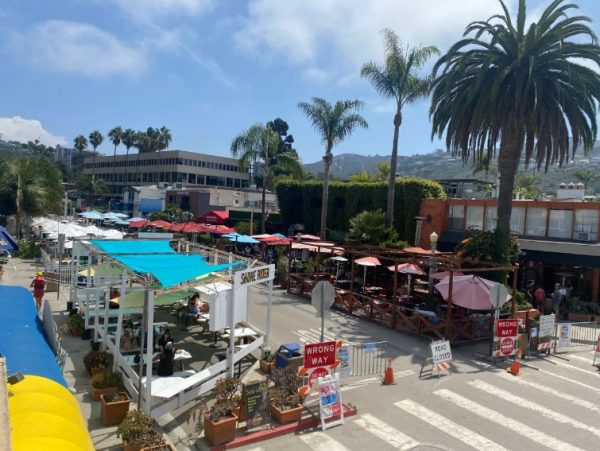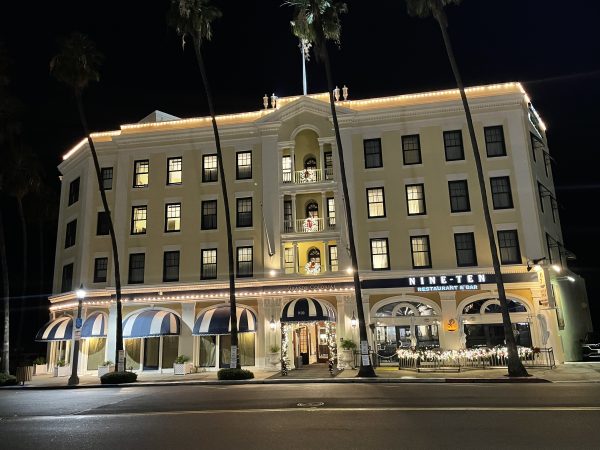A city of San Diego proposal to charge hotel and restaurant owners steeply higher fees for their valet parking spaces and on-street outdoor dining areas is drawing backlash from critics, including in La Jolla.
City officials say the proposed increases are justified because San Diego loses revenue when parking spots that could otherwise have meters are devoted to other uses such as dining or valet parking drop-off and pickup.
But opponents say the hikes are unreasonable and could prompt some restaurants to eliminate on-street dining and could cause hotel guests to clog streets by double parking.
Kim Avant, general manager of La Jolla’s Grande Colonial hotel, home to Nine-Ten Restaurant, said the hotel has long-standing, city-approved valet parking arrangements with five “loading zone” spaces in front of the property at 910 Prospect St.
“We learned last month that the city is proposing an increase in valet parking fees from approximately $600 per year for a valet operation permit to an additional $10,000 per parking space, which is not only unprecedented but also unsustainable,” Avant said. “An increase of this magnitude would have a devastating impact on small, locally owned hotels and restaurants like ours, and by extension, on the employees, guests and neighborhood businesses that rely on us.”
Darren Moore, co-chair of the La Jolla Shores Business Association and the owner of several restaurants in La Jolla, including Shore Rider, Dough Momma Pizzeria and Cove House, declined to comment on specifics of the city plan, saying he needed to understand it further. But in general, he said, large fee increases can be difficult for businesses to absorb, and the city should be thoughtful on how much rates go up.
Dave Abrams, a longtime member of the La Jolla Traffic & Transportation Board, said “I like the idea of street eateries, as I think they enhance and add life to the commercial area, but acknowledge the loss of precious parking spaces. I always thought the space the restaurants picked up in the street was a tremendous windfall of extra square footage and the city should recoup some substantial revenue in exchange.”
He added, however, that the argument that the city loses out on parking meter revenue by turning over street spaces for restaurant use “doesn’t seem to apply to La Jolla since we don’t have any meters here.”
 The outdoor dining program on Avenida de la Playa in La Jolla Shores is pictured in September 2023. (File)
The outdoor dining program on Avenida de la Playa in La Jolla Shores is pictured in September 2023. (File)
Abrams said valet parking spaces “are a good thing by taking vehicles off the street that might otherwise be circling around looking for parking within the vicinity. I know it has been argued that there are plenty of available parking spaces in La Jolla when you count all the parking structures and commercial lots, but unfortunately, people simply don’t use them to a greater degree.”
The proposal, which the City Council is scheduled to consider early next month, is part of a wider city campaign to cope with expected budget deficits by raising parking rates and beginning to charge in new places like Balboa Park.
City officials say on-street dining and valet spots are costing many thousands of dollars per year in potential parking meter revenue that could fund city services.
But Avant said “Valet fees were never intended to serve as a budget-balancing mechanism. They were designed to cover maintenance and manage turnover, ensuring access to local businesses, not to penalize them. … If enacted, this proposal would force businesses to raise prices, cut jobs or reconsider future investments in San Diego.”
The amount of potential revenue the city figures it’s missing out on rose sharply this year after hourly meter rates were doubled from $1.25 to $2.50, daily meter operations were extended by two hours and a special-event zone with higher rates was created near downtown’s Petco Park.
In an effort to recover a greater share of that revenue, city officials are proposing to raise the fees for street-dining space by more than 30% and to increase valet parking fees even more dramatically. Currently, those fees are nearly $38 per square foot in most areas. They would rise to $50.
Fees for outdoor dining would rise by nearly 32% in most neighborhoods and even more in the special-event zone. Also, a fee exemption would be eliminated for seating that is open to the public instead of reserved only for restaurant customers.
For valet spaces, hotels with the standard allotment of two valet street spots of 22 feet each would pay $5,600 per year, up from the current $600 per year. The additional $5,000 is a new fee that aims to recover part of the city’s costs.
The hotel industry has mostly accepted that change but is objecting to proposed fees for hotels that want more than two valet spots. Each additional valet spot beyond two would cost a hotel $10,000 in some areas and $15,000 in the special-event zone.
“That is just too high for guests, as well as the operators, to be able to absorb,” said Fred Tayco, executive director of the San Diego County Lodging Association.
Tayco said some hotels could end up paying close to $100,000 per year if they need several additional valet spots. And, he said, if they scale back valet spots, it could lead to dangerous double parking and unloading of luggage.
City officials say the proposed fees were carefully calculated based on the typical revenue a parking meter generates in a year.
Ahmad Erikat, a program manager in the city Transportation Department, said a typical meter downtown generated $25 per day, which may rise to $30 per day now that operating hours have been extended by two hours.
Erikat said the city multiplied the $30 rate by the 350 days per year that meters operate — there are 15 holidays per year when they don’t — to get a total expected revenue per downtown meter of $10,500. So the city decided to charge $10,000 for additional valet spots.
In the special-event zone, a similar calculation led the city to propose $15,000 per valet spot, Erikat said.
“The objective is to be as close as possible to cost recovery,” he said.
Avant argued that the city’s new formula “assumes each parking space generates revenue 24 hours a day, 365 days a year, which is simply unrealistic. Equally important, many hotels and restaurants in San Diego were originally approved with valet operations because self-parking options were never available. These arrangements were developed and approved in good faith under the city’s existing framework and fees.”
For restaurants or hotels willing to operate valet spots only from 5 p.m. to midnight, the fee would be $2,500, which is based on how much meter revenue could otherwise be generated during those hours, Erikat said.
He said the first two valet spots still would be heavily subsidized by the city. Instead of charging the $20,000 that officials say cost recovery would dictate — $30,000 in the special-event zone — the city would charge $5,600 for those two spots.
The proposal was approved 4-0 by the City Council’s Active Transportation and Infrastructure Committee last month. It is expected for a vote by the full council Nov. 3 or 4.
Councilman Stephen Whitburn, who chairs the committee and represents downtown, said he sympathizes with businesses facing higher fees.
But he said the proposed policy “enables valet services to remain possible while enabling the city to recover the true cost of lost parking revenue.”
He added that “the collection of valet parking revenue results in some pretty significant revenue” for hotels and that he believes they make enough money to cover the higher costs.
Eric Christiansen, who has operated Guava Beach Bar & Grill in Mission Beach for 23 years, said he considers the fee increase for street dining a huge mistake.
“It’s a ridiculous increase by a tone-deaf city,” Christiansen said.
With the city’s minimum wage still rising incrementally and costs for food and energy going up, the city shouldn’t charge more for street dining spots when restaurants are barely surviving, he said.
“We can’t absorb any more costs — we are teetering,” Christiansen added. “It’s going to be a rude awakening for the city when restaurants start to close. Boarded-up buildings are a bad look for tourists.” ♦

